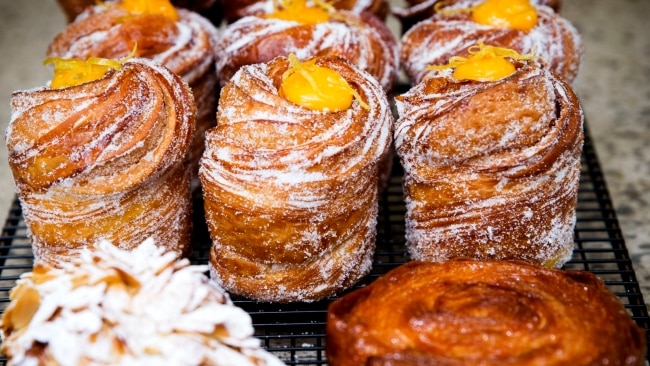Lune Croissants: Yes, Melbourne's best croissants are worth the queue
They've been called the best in the world, but are these croissants really worth the wait? Here are five reasons why Melissa Leong's answer is a resounding yes.

There are few things in life that I will queue for.
It isn’t that I think I’m too good for it, I’m just impatient. I ask myself how much I want what’s at the head of it, and so very rarely is that prize worth it. When I first moved to Melbourne, on a crisp wintry day, I found myself walking through the backstreets of Fitzroy on my very first pilgrimage to Lune Croissant. When I walked past the line snaking out the door and around the block – like, really down the block – I thought to myself, is this really worth it? Call it the siren’s lure for butter-laminated carbs, call it a croissant cult – I caved and joined the line. Lune’s allure and mythology under the power of its creator, Kate Reid, is real. But is it really worth queueing up to an hour for one? Here are five reasons ...
1. They're engineered perfection
The thing you need to know about pastry chefs is that they are an exacting bunch. Pastry alchemy doesn’t just happen if you add a little bit of this and a little bit of that and hope for the best. Perfect pastry is born from people with a relentless obsession for detail, science, and art in equal measure. And Lune’s visionary Kate Reid is all that and a packet of chips. After graduating with a degree in aerospace engineering from RMIT before going on to be the only female Formula One engineer among about 120 colleagues in her sphere as an aerodynamicist in the hallowed halls of Williams F1, she now lends her incredible mind to a world of butter, lamination, and layer upon layer of golden, flaky perfection. She still likes to drive fast, high-performance vehicles, by the way.

2. THAT butter
I hate to break it to you, but not all butter is alike. Just like any natural produce, the final product has a lot to do with what goes into it. The environment, the way the produce is collected and processed with skill and knowledge. Lune uses Beurre d’Isigny, which comes from Isigny-sur-Mer, in the north of France. Why? Because, according to Reid, it’s the best for what she does. These cows graze on grass-topped cliffs that overlook the ocean and aside from probably having a rather nice life, the naturally occurring salinity from the sea finds its way into the grass and therefore the butter, yielding its own specific flavour profile to the croissant-making process. And if you knew how much butter went into making a croissant, you’d be gunning for the best you could access, too.

3. It's more than a croissant in a bag
If you thought that this was just a croissant bakery, think again. Not satisfied with being the hyperfocused destination for possibly the best croissants in the world (according to the New York Times), there’s also Lune Lab. Book one of eight seats overlooking the glassed-in cube that is the raw production kitchen and enjoy a three-course set menu that pushes the limits of what croissant pastry can be. More than just a Danish on a plate, these are highly composed dishes that showcase seasonality as well as to-the-moon-and-back ideas.

4. It's a Melbourne rite of passage
I never want anyone to suffer, but sometimes, if you have to work for something good, it somehow feels (or tastes, in this case) even better. With that in mind, there’s something to be said for rugging up on a brisk Melbourne morning with your bestie and a reusable coffee cup full of whatever sustains you, and joining the queue for a Lune croissant.
Sure, we’d like to feel like VIPs and skip the queue, but there’s also something community in feel about picking up on the excitement of other pastry-obsessed people, together creeping closer to the front of the queue. If you wouldn’t mind grabbing me a ham and Gruyère while you’re at it, that would be great. It’s a classic for a reason, baked with a filling of shaved ham, Swiss Gruyère and seeded mustard. Each bite is savoury and perfectly seasoned, at once feather-light yet rich and comforting – and gone in seconds.

5. They’re really bloody good
I suppose it would be remiss of me to not leave you with what I really think about the actual croissants themselves. Since I’ve discussed how I’ve queued and crushed croissants at Lune many times since that first Fitzroy pilgrimage, you probably already know what I’m going to say. Croissants are a luxury. As such, when you want to eat one, you want it to be everything it could and should be. Making a pastry that culminates in an explosion of a million flaky layers encasing a soft, tender heart that smells better than a (clean) newborn baby takes skill, love and obsession. Folding, proving, laminating – the work that goes into each pastry at Lune is why each bite is so well balanced, multi-textured and ephemeral in the eating. It’s a lot of hype for a piece of pastry to have, so let’s put that aside for a moment and just appreciate a Lune croissant for what it is: really bloody good, and well worth queueing for.
Fans of Lune can now try their hand at home with Kate Reid’s first book, Lune: Croissants All Day, All Night (published by Hardie Grant, $55), available now.
See also:
9 dishes around the world Melissa Leong will travel for
Best food we've discovered on Aussie road trips
This cake is worth driving hours for
Originally published as Lune Croissants: Yes, Melbourne's best croissants are worth the queue



